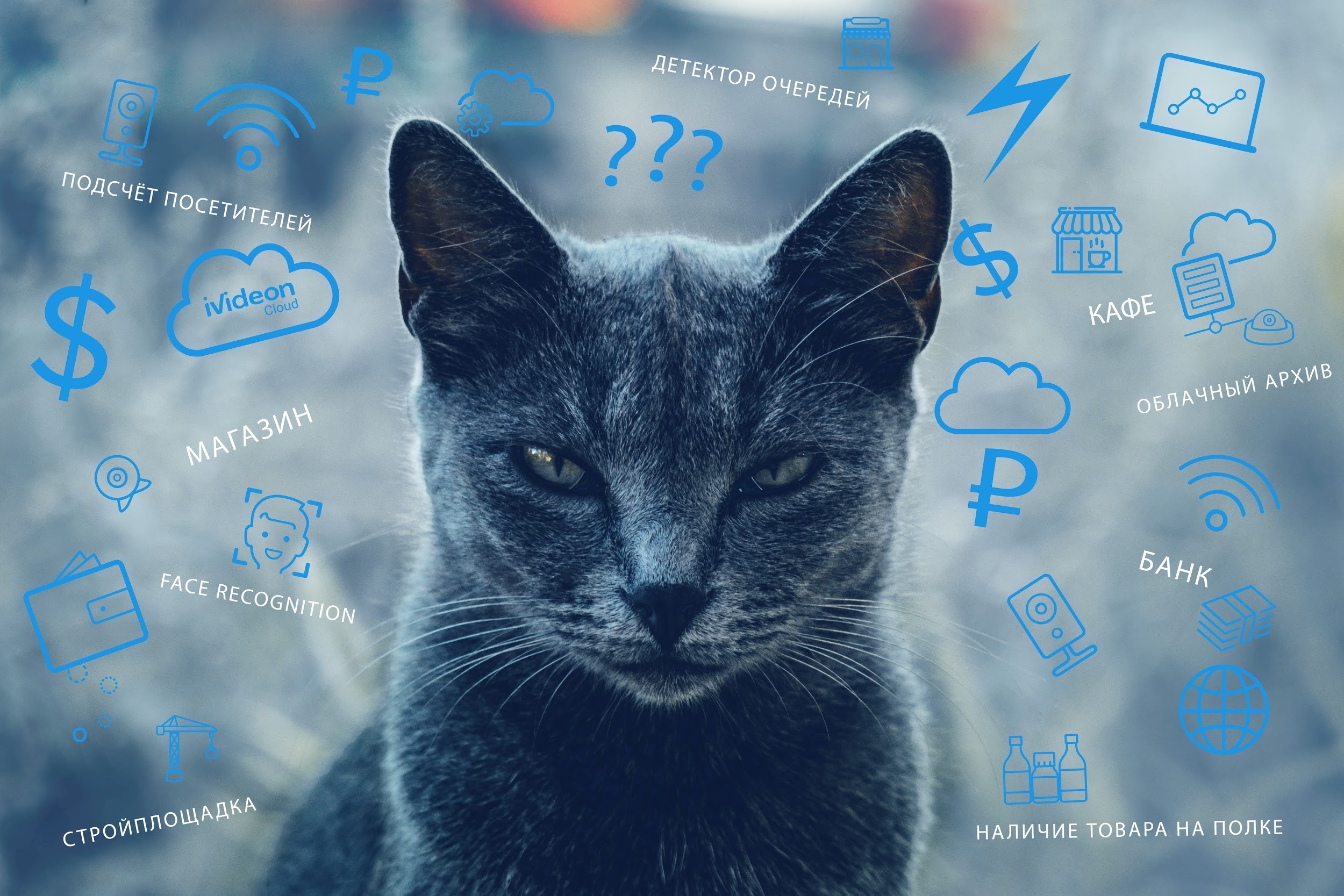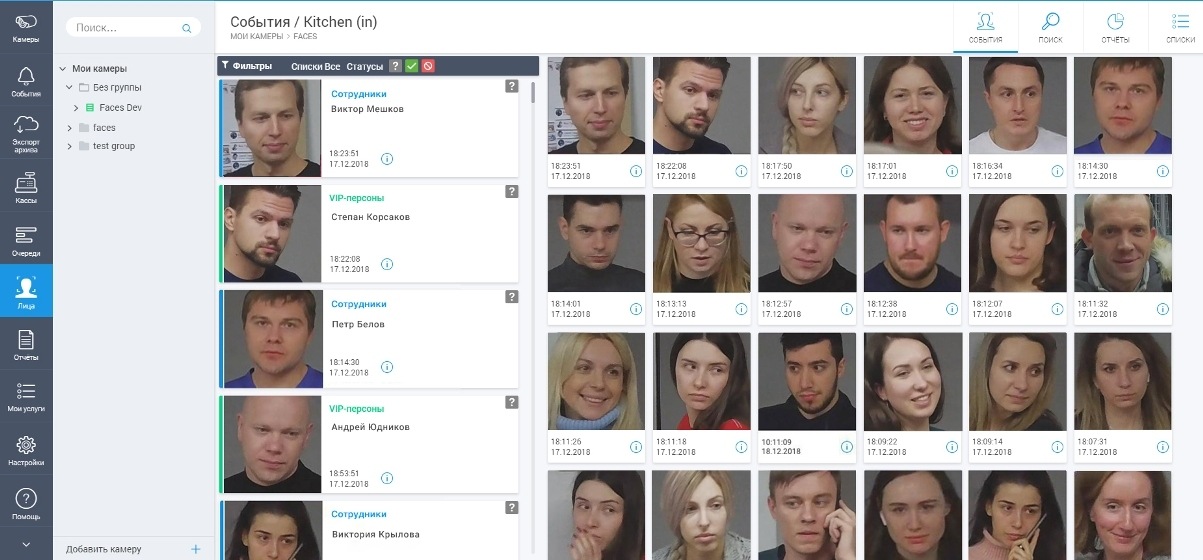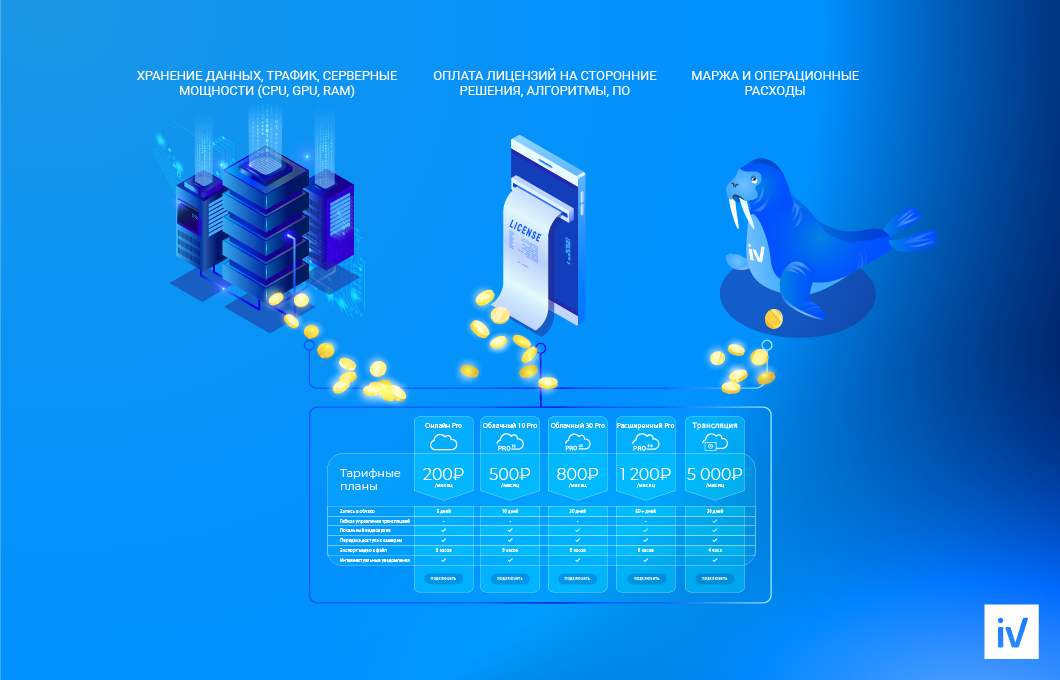Monetization of the cloud: how to attract customers and not go broke

It is easy to believe that VSaaS sells itself. In ideal conditions, by connecting one camera and getting an affordable cloud-based video surveillance service, the client quickly understands how it all works and goes to connect the paid rates. He adds new cameras and services, works with video analytics, solves more and more of his tasks, and recommends VSaaS to his friends and partners.
In fact, on this path, any network service provider will face such calls that no one really likes to talk about, although the cloud business faces them almost every day. These challenges predictably relate to money. The most important and difficult task is how to count and sell the cloud, doing well both to the user and yourself.
Billing and payment as the first stage of a migraine

')
VSaaS consists of several components, among which they distinguish directly the broadcast of video from cameras, video hosting, intellectual analytics and a complex of additional connected services. The number of available features and modules increases year after year, and this is good for the user. But their abundance can cause difficulties for providers in the formation of the correct pricing policy.
Each VSaaS-service has its own pricing unit, mechanics of connection and renewal, requires separate accounting. For example, payment for a cloud archive service is calculated based on its depth, that is, the retention period for records, and analytical services are charged based on the number of transactions.
We at Ivideon set a time limit only - for example, over the past 30 days, regardless of the amount of traffic, although data centers pay for terabytes. Some cloud providers link the cost of tariffs directly to the amount of traffic. And this traffic video services generate a lot!
An IP camera with a resolution of 640x480 and 25 frames / sec (H.264) with continuous recording with an average traffic intensity in a frame for a day generates 11 GB of video data. For the same camera with a very heavy traffic in the frame, the amount of traffic is approximately 450 MB per hour.
However, a camera with a resolution of 640x480 is now the exception rather than the rule. Everyone wants to see a good picture - at least 2 MP. As a result, generated huge traffic! In 2016, Martin Gren, co-founder of the well-known manufacturer of video equipment Axis Communications, said that all YouTube is the equivalent of only 16,000 channels / cameras, which is quite a bit by the standards of video surveillance systems.

By traffic or by day of use, the most popular VSaaS module - video analytics can be considered. But we went the other way and tied the face recognition module to the number of transactions. An example of a transaction in the case of Face Recognition is the recognition of a face image and its comparison with the database of persons.
Why don't we use a “common denominator” for all services and tariffs? Because this is a real headache - it is impossible to compare the square with the soft. The range of services is too wide and constantly growing, but the line of tariffs must remain clear and transparent to the user.
Cloud services today often follow a trend when customers are offered three, maximum four tariffs. The simplicity of such a decision is deceptive and does not suit customers whose number of cameras installed and connected to the service is thousands.
Our billing includes individual sets of options. Sometimes it is better to form more different tariffs from different services, for different clients - and this will be more convenient for the user. For example, on the site we offer a maximum video storage period of 60 days. At the same time for some customers have prepared individual tariff plans with a shelf life of several years.
It is convenient for the user to choose a tariff with an understandable form of payment: for example, to deposit a fixed amount on a monthly basis. To make this possible, the VSaaS provider needs to put in order disparate services and develop a tariff line without prejudice to its billing system.
"Sacred Cow": how to cut on the living and not to kill anyone during billing

The “Sacred Cow” of various Internet service providers is convergent billing, that is, a payment system in which the service is able to issue a single bill to the customer for many different services paid in advance or upon use. Moreover, it does not matter what is the unit of measurement services - minutes or bytes.
It is sometimes impossible to build a single payment model from scattered “blocks”. The VSaaS product that the user receives consists of dozens of “ingredients”. For example, third-party service modules and hosting in several data centers are involved in Ivideon.
We have different payment models with different suppliers - with someone according to the pay-as-you-go model (payment scheme for the use of cloud resources “pay only for what you used”), and someone charges a fixed amount on a monthly basis. We work with clients according to the prepaid model.
Prepaid is a method of payment with the provider, in which the user pre-adds the amount to the account.
Choosing one model, the provider to some extent becomes its hostage. It is not always possible to turn around 180 degrees and change the model from “prepaid” to “pay-as-you-go” in a short time. Perhaps the market dictates that now you need to sell the service in a different way, but changing something can be very difficult.
Like all B2B service providers, we work with legal entities, and in the supplementary agreements to the contracts we have the exact numbers that the user pays for a specific period. When moving from one model to another, someone will become more expensive, someone cheaper, and we will have to talk to everyone.
Plus there are partners who use our billing and face the same problems. With them, we are also linked by contractual relations. Taking into account the size of our user and partner bases, this is an incredible amount of contractual and organizational work. But there are also technical aspects: the introduction and verification of the necessary mechanisms, counters, metrics. As a result, there is a tremendous stress for the business, which can seriously affect the profitability indicators for the period, even if it will bring benefits in the future.
How we form prices or what you pay for by purchasing a cloud subscription

The billing system of VSaaS providers is closely related to accounting and management accounting. It serves as one of the main sources of data allowing to form and adjust tariffs. Incorrectly constructed system and incorrectly collected data will not allow to make accurate predictions and affect sales of services.
If an error is made somewhere, the provider simply cannot understand how much money one user brings to it, and if it does not work at a loss. As a result, he will not be able to form a tariff advantageous for himself and the user.
The service usage profile is not equal to the tariff. A user who writes to the cloud in 24/7 mode costs us more than a person with the same tariff, in which the camera “comes to life” once a day, when the door is slammed from the wind. Thus, two users with one tariff manage to us in the different sums, therefore, and we will receive the profit different.
The use profile fits into the tariff only with some approximation: it is closer to pay-as-you-go than to prepaid, but there is still no direct match. From inconsistencies the provider can incur losses, and the user overpay. Therefore, one of the key tasks of billing is to make sure that the service usage profiles and tariffs do not contradict each other.
You can go on the "easy" way: often change the cost of services, refuse popular tariffs for customers as soon as problems arise with them, and generally complicate the payment system for the user. All these measures will really help to solve the problems of the provider, but they are not considered with the convenience of customers, and logic dictates that it is easy to lose user confidence, and it is more difficult to win again.
Another way requires the skills of forecasting and the ability to solve atypical tasks. This allows you to prepare in advance for possible difficulties. Ivideon has an affiliate program for vendors, distributors, integrators. Keeping a record of one “own” user and several “partners” are two different tasks. Simply put, in each case it is necessary to correctly calculate who, to whom and how much should.
Thinking in advance about how to develop the service in terms of interaction with agents, we took a large "piece" of the back office under this particular account. If you do not think through such aspects of work, they become “bottlenecks” that become a real problem.
Customers have the right to demand and want something special.
The cloud video surveillance service is used by home users, small, medium and large businesses; gas stations, small shops and entire retail chains - they all deploy video surveillance systems, and each client has his own tasks, priorities and needs.
For small businesses, for example, the determining factor in choosing a tariff is often the price, and for large enterprises the possibility of package customization is more important. Technological productions require unique analytical services, and banks need synchronization with the corporate local system. Ideally, the VSaaS provider should provide each client with what he asks.
It is necessary to take into account regional peculiarities. Services are perceived differently in different markets. What we can offer in Russia as a paid service is a given for American users. The reason is that the US market is oversaturated: it costs companies like Wyze Cam to come up with the offer of perpetual and free storage, as the same cloud archive no longer looks unique to the user.
Different requests require service flexibility from VSaaS providers - this should be configured. In order to form a service that is universal in terms of quality, it is necessary to simplify the connection of new modules and predict usage scenarios in each segment.
For small businesses, price is important - it means you need to prepare an affordable tariff that solves the problems of this segment and can compete with alternative offers. For example, for retail, we came up with a business management tool - video analytics - at a price of 1,700 rubles. behind the camera for face recognition.
The user understands the value of the service package for his company and is ready to connect it. The task of the provider is to prepare as many packages as possible for different types of businesses, based primarily on whether they are beneficial and solve a specific task.
As for the convenience of connecting modules, it is important to simplify this process as much as possible, so that the user can try a new service and, if necessary, easily refuse it (perhaps he will refuse any services, but he will find what he really needs, - without fear of marketing tricks).
Another useful tool for different types of users is progressive discounts. They allow customers to save when paying for a large number of devices, and the provider - to encourage users with systems of various sizes.
The grinder of competition: flexibility, alliances, innovations
One medical analysis company built a video surveillance system with the help of our competitors, but was unhappy with the user experience. For a long time, the company negotiated with us, and its supplier at the same time lowered the price lower and lower to keep the client.
The situation was complicated by the fact that the system was used at hundreds of points throughout the country, and migration seemed too complicated. As a result, the company remained on the old solution - albeit uncomfortable and unsatisfactory for the client. The provider himself suffered from a poor-quality service - although he won at the moment, but he could not solve the client’s problems and, quite possibly, spoiled his reputation, thereby slowing down his own development.
Players behind whom there are large investments can afford to lower the price of their services for a long time, even at the expense of the quality of post-maintenance. But at the same time, such companies are too slow to develop individual solutions. But all it takes is to make a quality product at the request of any client and thus compete with competition.
For example, we have various offers not only for large and small enterprises, but also for kindergartens, fitness centers, banks, business centers and other facilities. It is clear that safety and security of materials is important at construction sites, and in beauty salons they pay great attention to customer service. Based on this, we offer individual solutions to different types of companies that close their priority tasks.
Another way of healthy competition is alliances. As a platform for cloud-based video surveillance and analytics, Ivideon is fundamentally open to partnership with manufacturers of cameras, smart home kits, security systems, and other equipment. We work with Dahua and Hikvision, Axis Communications, the British ACS developer Paxton, Hanwha Techwin (Samsung), Russian developers of hardware and software systems OPS - Bolid, Teko and others.
And the last weapon in the space of proper monetization is innovation. The requirements of users for analytic tools in video surveillance are growing, therefore, there are more chances to gain a foothold in the market for those providers who rely on innovative services and integration with other vendors and systems.
The development of new services is also a good way to attract funding. Investors pay attention to many parameters, evaluating the company. “Powerful” service in the VSaaS-provider inventory can be a decisive factor for them. Our practice shows that with investments it is easier to cope with any challenges of the market and to hone the “flexibility” of the service. Although responsibility grows.
***
Balancing between the interests of the user, who, at first glance, always wants a lower price, and their own needs, formed by the eternal truth “business must be profitable,” is tempting to start saving on the quality of equipment and services. This is a trap, the victims of which are both parties to the transaction. The problem of balance in the VSaaS market is solved simply: to create a convenient and high-quality service for the user, implement the functions that customers need, and remain stable as a service.
Source: https://habr.com/ru/post/443682/
All Articles